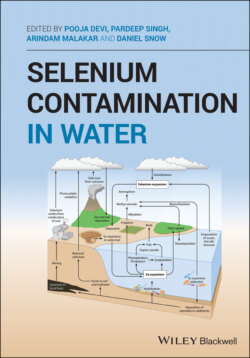Читать книгу Selenium Contamination in Water - Группа авторов - Страница 29
2.6 Conclusion
ОглавлениеSelenium is an essentio‐toxin element with chemistry similar to that of sulfur. Several Se species are available in nature and are distributed widely in soil and water. Physico‐chemical properties including originating rocks, pH, redox potential, organic matters, microorganisms, mineral, properties of clay, competing ions, etc. are responsible for the incidence of the different Se species in soils. In soil the main sources of Se are seleniferous rocks, burning of fossil fuels, disposal of Se‐containing industrial waste and addition of agricultural products, etc. These sources are responsible for the accumulation of different chemical species of Se in soil. Depending upon Se concentration in soil can be divided into toxic, moderate, and deficient levels which may exist side by side. Bioavailability of Se in the plants and crops supported by soil depends on local environmental factors, e.g. in acidic pH range (4.5–6.5), rich in OM, presence of strongly reducing species and also in the region of low rainfall, non‐toxic seleniferous soil predominates, i.e. insoluble selenide (‐II) and elemental Se(0) forms are present majorly. In a solution of well‐aerated alkaline soil selenate and selenite are the most soluble species but the presence of such species may change. In humid conditions the occurrence of accumulated zones of minerals renders the bioavailability of Se to plants. The interaction of Se species with OM including fulvic acid is more bioavailable than humic acid because interaction of Se species with humic acid immobilizes Se and therefore becomes less bioavailable. Sorption and desorption process in the presence of clay content, OM and minerals in soil play a crucial role in bioavailability of Se. Sorption of Se is at its maximum between pH 3 and 5 and therefore it is less available for plants in loamy than in sandy soil. Besides this, OM facilitates the simulation of microbial activity that changes the oxidation state of Se (VI to ‐II). This may also result in methylation, which facilitates strong binding of Se to OM. The reduced form of Se is sorbed on OM and less mobile. Fungal growth in the presence of OMs affects the mobilization of Se and its availability hindered dramatically from soil to plant. Se concentration in soil also varies along the depth profile of soil. Presence of free calcium carbonate and increased pH (alkaline) reveals toxic seleniferous soils. To evaluate Se contamination understanding related to particulate Se is important, because every species has different bioavailability. The bioavailability of Se in soil follows the following order: selenate (Se6\+) > selenomethionine > selenocysteine > selenite (Se4+) > elemental selenium (Se0) > selenide (Se2−). Remedial treatments are highly desired to overcome the problems related to Se pollution by industrial waste. To this end it has been proposed by the researchers that treatment of industrial discharge is necessary before disposal. On the other hand it can be minimized by reducing the concentration of Se level in the soil by encouraging use of gypsum, OM such as mud, and poultry manure. Besides this, there is also more‐advanced in‐situ bioremediation by different bacterial cultures to reduce or tolerate Se concentrations in soil.
